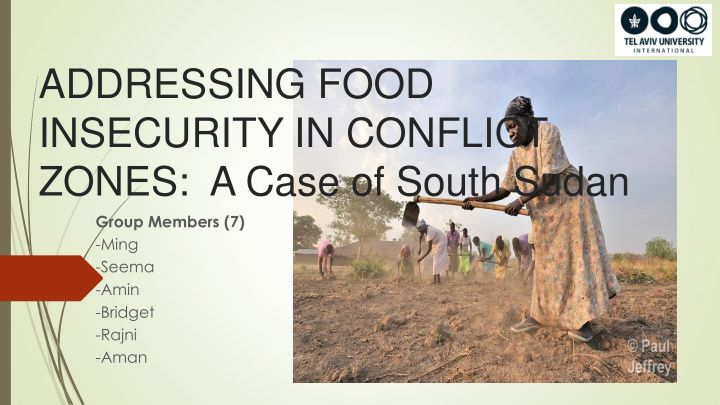



ADDRESSING FOOD INSECURITY IN CONFLICT ZONES: A Case of South Sudan Group Members (7) -Ming -Seema -Amin -Bridget -Rajni -Aman
Understanding the context: SOUTH SUDAN South Sudan is the world’s newest country. It became independent from Sudan in 2011 after 20 years of war between north and south Sudan. Over 20 million people were killed In 2015 a peace agreement was signed by leaders of two competing parties. But tensions between the two main parties led to violence in Juba in July 2016 South Sudan was already experiencing economic vulnerability, where many households were at risk of not having enough food in the cities and rural areas
SOUTH SUDAN : Humanitarian Snapshot (June 2018)
COUNTRY’S CONTEXT CONTINUED 5.3 million (56%) people face extreme food insecurity • 270,000 South Sudanese children are now severely malnourished • 2 million people are on the brink of starvation Millions of people have been displaced • 1.8 million internally displaced persons • 1.5 million refugees CARITAS AUSTRALIA & FAO
Factors contributing to food insecurity Conflicts Economic decline Drought Other natural disaster - floods Rising global food prices
UNDERSTANDING FOOD SECURITY Food security exists when all people, at all times, have physical, social and economic access to sufficient, safe and nutritious food which meets their dietary needs and food preferences for an active and healthy life (FAO ) Food security encompasses 4 pillars namely Availability Access Utilization Stability
FOOD INSECURITY & FAMINE A famine is a severe food crisis. It is declared by the United Nations when the following criteria is met: 4 out of every 10,000 children are dying from lack of food, 20% of people are unable to meet their daily food requirements and function effectively (unable to go to work or school) 30% of people are acutely malnourished
The Integrated Food Security Phase Classification (IPC) http://www.fao.org/docrep/013/al936e/al936e00.pdf
Context of conflict Zone and Food Insecurity Limited agriculture production (availability ) Depletion of livelihoods (Availability) Limited food sources – poor diets (Availability &Utilization) Disruption of communication infrastructures (Availability) Displacement of citizens from their – agriculture lands (access) High mortality and morbidity Poor sanitation and hygiene (Utilization ) Importation of food from neighboring countries (Access)
Interventions to Manage Food Insecurity & Malnutrition Early distribution of planting materials to farmers in relatively peaceful areas Introduction of fortified crops to manage nutrient deficiencies in nutrient deficient crop staples Early intervention in provision of needed food support to farmers – reduce bureaucracy Need for strong relationship between government and humanitarian actors involved in food security interventions Education on behavioral change models to improve sanitation Encouraging urban gardening to address malnutrition Improving road access within farming communities and beyond (flooding is common)
Interventions continued … Encourage farmers to diversify livelihoods sources Improve access to water resources; 1. Improve sanitation & hygiene 2. Simple irrigation community projects Training of farmers on sustainable agriculture practices Giving cash vouchers to enable farmers buy planting materials Nutrition interventions targeting the the most vulnerable people
Conclusion Managing food security in conflict areas requires the intervention of a number of actors; Humanitarian agencies & government - capacity will in most cases need to be built in the long run by the former. Relevant approaches to be adopted for addressing food insecurity by humanitarian actors and whoever is involved in food security will require thorough understanding of the complexities of situation on ground. Putting in place short and long term solutions Secondly there is also need for flexibilities in devising workable solutions – Reliance on old models
Thank you
Recommend
More recommend